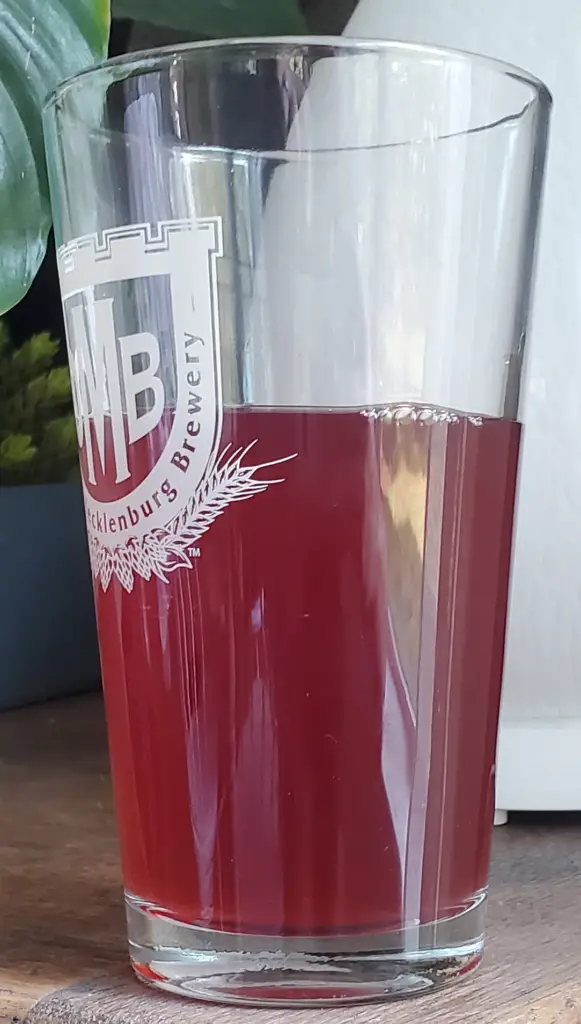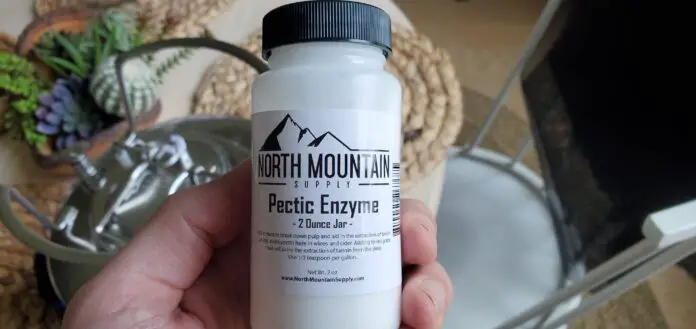There’s a lot of discussion out there about enzymes and fining agents in your homebrew, including pectic enzyme, and it can get very complicated! It is a bit of a more advanced consideration, and probably isn’t a concern quite yet for you new brewers out there. But if you’re trying to improve your skill and produce the best mead, wine, cider, or beer that you possibly can, at some point you have to ask: should you use pectic enzyme, and if so, how do you do it?
Pectinase (pectic enzyme) is used to break down pectin in meads, wines, and ciders made from fruit. It is used primarily to clarify the brew, but there are arguably more important reasons to use the enzyme. While it is not absolutely necessary to use pectinase, it is strongly recommended when using fruit.
For the longest time, I didn’t use pectic enzyme in any of my brews.
I thought that the only reason to break down pectin in your meads, wines, and ciders was for the sake of clarity. And while I try to achieve a certain amount of clarity in my brews (primarily through patience) I’m not generally concerned about them being perfectly clear – as long as it doesn’t affect the taste.
However, all of that has changed more recently, as I’ve come to learn more about the subject. As it turns out, clarity isn’t the only reason for using pectic enzyme – it’s not even the most important reason!
Having pectin in your brew actually does influence the way you experience it, including how it tastes!
So, while it is not 100% required to use pectic enzyme in your meads, wines, and ciders, in most cases where the brew involves the use of fruit or fruit juice, it is strongly recommended to use the enzyme if you want to produce the best homebrew possible.
What Is Pectinase (Pectic Enzyme)?
Pectinase is an enzyme that breaks down pectin.
As an enzyme, pectinase is a protein whose specific shape allows it to interact with another molecule that has a specific shape – in this case, pectin.
The enzyme acts to cleave the pectin molecule into two smaller parts. This is the important part.
Additionally, as an enzyme, pectinase is not consumed in the cleaving process; it can go on to interact with and cleave other pectin molecules.
This means that just a little bit of pectinase goes a long way! In fact, more of the enzyme may do the work a bit faster, but doesn’t do a better job.
What Is Pectin?
Pectin is a gel-like substance, found in fruit, that holds the cells of the fruit together.
It’s the reason that fruit keeps its shape. Without pectin, fruits would be almost completely liquid! You can see this in very overripe fruit – it liquifies as bacteria breaks down the pectin (interestingly enough, the bacteria uses pectic enzyme to do so, just as we do in our brews!).
Pectin is actually very useful to us in many ways, culinary and otherwise – most commonly, it’s used to give jams and jellies their texture and consistency. But in brewing, it’s often more of an obstacle than a benefit.
The most obvious thing it does to our brews is create pectic haze, which leaves the drink cloudy. For some who prefer incredibly clear brews, that’s a problem.
But that’s not all it does! The pectin can actually trap other substances inside of itself.
These trapped substances can hold color or aroma from the fruit, or even sugar and nutrients.
Without cleaving the pectin and releasing these substances, your batch can end up without the vibrant color or wonderful flavor and aroma you were hoping to get from the fruit.
More importantly, it can actually trap fermentable sugars, making it harder for the yeast to get to them. This can result in a slower, less efficient fermentation!
I didn’t actually know this for a long time! I just thought pectic enzyme was used to prevent pectic haze – but it can actually help your batch in many other ways, making the end result more vibrant, aromatic, and flavorful.
Do You Need Pectinase (Pectic Enzyme)?
So that begs the question: do you actually need to use pectic enzyme? After all, as I said, I never used to use it at all, because I don’t care as much about aesthetics and clearing pectic haze.
You do not necessarily need to use pectic enzyme in your brews, and there is no benefit to using it in any homebrew that does not contain fruit. However, for nearly all batches with fermenting fruit, breaking down the pectin has many benefits and is strongly recommended.

Your batch will ferment (and ferment dry!) even without the use of pectic enzyme. It is not necessary to produce alcohol from fruit. You can simply add yeast to fruit juice and you’ll get a fermentation going!
However, most of the time, if you’re using fruit (or fruit juice!) at all in your batch (even if it’s not the primary source of sugar!) you really should be using pectinase.
As stated above, pectin causes more problems for your brew than just creating a bit of haze. It actually traps substances inside, muting the color, aroma and flavor, and making it difficult for the yeast to access some of the sugar!
To make the best batch of fruited mead, wine, cider, or beer that you possibly can, it’s strongly recommended that you use pectic enzyme to break down the pectin and prevent those issues.
When Don’t You Need Pectinase (Pectic Enzyme)?
It’s important to note: this is only important for fruited meads, wines, ciders, and beers. If you are brewing a batch that is made entirely from grain, honey, plain sugar, or anything else that isn’t fruit, you do not need pectic enzyme. In fact, adding it to something like that won’t do anything – without fruit, there is no pectin to worry about.
Additionally, I said most of the time. Some fruits, like strawberries and apricots, have very little pectin to begin with, and may not need pectic enzyme. However, it doesn’t hurt to add it, so you might want to, anyways, just to be safe.
How to Add Pectinase (Pectic Enzyme) to Your Batch
Pectic enzyme is really easy to work with. Just add a bit to the must before you pitch your yeast!
For most brews using store-bought juice or the juice from crushed fruit, you only need about a ½ teaspoon per gallon of must.
However, if you are using whole fruit, you will need 1/10 tablespoon per pound of fruit. This isn’t done often by homebrewers, but commercial wineries and cideries that grow and harvest their own fruit will often do it this way before crushing and pressing the fruit.
(You can add a bit more or less than is recommended, though. Remember, the enzyme isn’t consumed in the cleaving process, so a little bit can work on the entire batch of must. It just takes more or less time to finish based on how much you add!)
You want to add the enzyme at the start of the brewing process – before pitching your yeast. Ideally, you should add the enzyme to the must a full 24 hours prior to pitching yeast – but leaving your juice or must in the fermenter for that long can be a potential contamination or even oxidation hazard, so doing it the same day isn’t that big of a deal.
The reason for doing it so early is because the presence of alcohol dramatically inhibits the enzyme’s ability to work on the pectin. It doesn’t stop it entirely, but it can slow it way down.
If you are adding the enzyme late, you will need to add more of it, or wait longer.
In fact, if you forgot to add the enzyme prior to pitching, you can still add it later – even in secondary, after fermentation has been completed! Of course, if you do it at that point, you’ll need to add a lot more pectinase, or way a whole lot longer, for it to do its job.
Pectinase usually comes in powder form – you can simply sprinkle it directly over the top of the must and let it mix in naturally.
Pectinase (Pectic Enzyme) Storage
You only need a little bit of pectinase for even a large batch of mead, wine, or cider, and it usually comes in a container that will last you many, many batches. So you’ll need to keep it fresh in between uses!
It lasts quite a while, even at room temperature, so you can happily keep it in a drawer or a closet.
However, it will store much longer if refrigerated – so for best results, keep it in the refrigerator, as close to 32°F as possible.
Conclusion
While pectic enzyme is not necessary for the complete fermentation of fruit or fruit juice, it really oughtta be used in any batch that uses fruit as a fermentable sugar.
The pectin in fruit does a lot more harm to your batch than just creating some haze. It actually affects the taste and the overall experience of the brew!
So for any batch of homebrew that uses fruit, it’s strongly recommended that you add pectic enzyme to break down the pectin and improve your brew.



